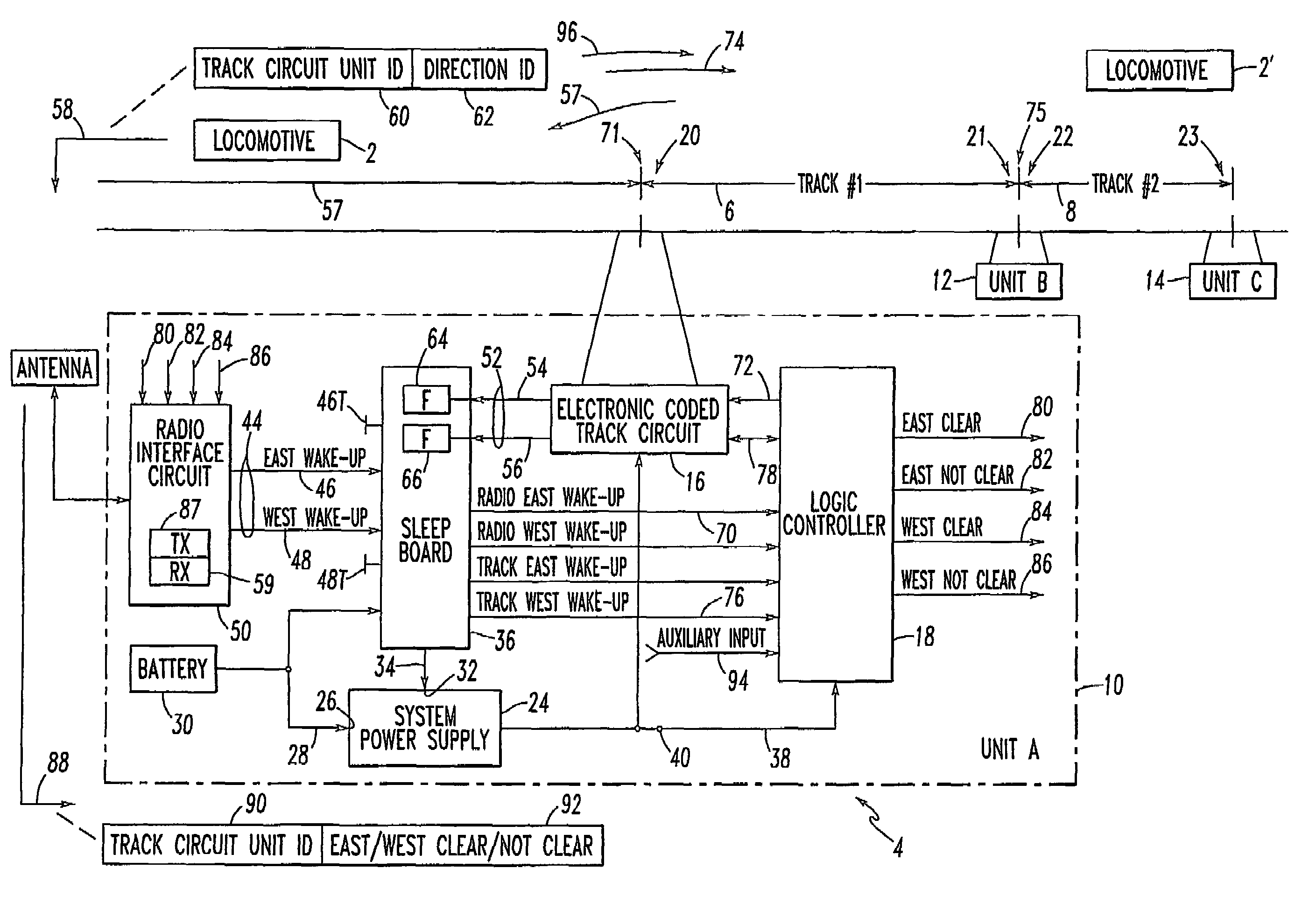Method and system providing sleep and wake-up modes for railway track circuit unit
a technology of railway track circuit and sleep mode, which is applied in the direction of railway signalling, transportation and packaging, and signal operation from vehicles, etc., can solve the problems of inherent delay and probably excessive time delay
- Summary
- Abstract
- Description
- Claims
- Application Information
AI Technical Summary
Benefits of technology
Problems solved by technology
Method used
Image
Examples
example 1
[0035]A train, such as locomotive 2, is approaching the track circuit Unit A 10 in an Easterly direction (e.g., from the left to the right side of FIG. 1). A radio message 58 with identifier 62 being East Wake-up is received by the radio interface circuit 50, which outputs the signal 46. The sleep board 36 activates the ON state of the ON / OFF signal 34 in order to activate the system power supply 24 and, also, sets a Radio East Wake-Up (REWU) signal 70 to the LC 18. The signal 70 instructs the LC 18 to begin track communication on the East side of the insulated joint 71 at location A. In response to a signal 72 from the LC 18 to the electronic coded track circuit 16, that circuit 16 sends a track message 74 on Track #16, which is received by the corresponding electronic coded track circuit 16 (not shown) of the track circuit Unit B 12. That message 74 is received on the exit or B end or East end 21 of the track circuit for Track #16, which is the West side of the insulated joint 75 ...
example 2
[0036]The signals 80,82,84,86 are output by the LC 18 to the radio interface circuit 50. The signal 84 signifies West Track Clear and the signal 86 signifies West Track Not Clear. The radio interface circuit 50 broadcasts (e.g., to the train initiating the wake-up) from radio transmitter (TX) 87 a message 88, which includes a first identifier 90 to indicate that the transmitter of the message 88 is the track circuit Unit A 10, and a second identifier 92 to indicate that the message corresponds to one of the signals 80,82,84,86.
example 3
[0037]The radio message 58 from the locomotive 2 to the wayside locations, such as the track circuit Unit A 10, may be in a periodic intermittent form (e.g., 1 second on; 15 seconds off). In this manner, when the periodic intermittent messages 58 are no longer received (e.g., after a timeout of about 30 seconds), the sleep board 36 may restore the sleep mode. This occurs as a natural progression of train movement. For example, as the locomotive 2 progresses toward Track #16, there is no further need to interrogate Track #16 and the locomotive 2 would, then, radio wake up track circuit Unit B 12, in order to interrogate Track #28 and the wake-up messages 58 to track circuit Unit A 10 would terminate. Then, with the radio wake-up to track circuit Unit A 10 being terminated, that unit reverts to the power saving sleep mode. In the event that test buttons 46T,48T for the respective signals 46,48 are employed, then a longer timeout period (e.g., a number of minutes; an hour) may be emplo...
PUM
 Login to View More
Login to View More Abstract
Description
Claims
Application Information
 Login to View More
Login to View More - R&D
- Intellectual Property
- Life Sciences
- Materials
- Tech Scout
- Unparalleled Data Quality
- Higher Quality Content
- 60% Fewer Hallucinations
Browse by: Latest US Patents, China's latest patents, Technical Efficacy Thesaurus, Application Domain, Technology Topic, Popular Technical Reports.
© 2025 PatSnap. All rights reserved.Legal|Privacy policy|Modern Slavery Act Transparency Statement|Sitemap|About US| Contact US: help@patsnap.com



